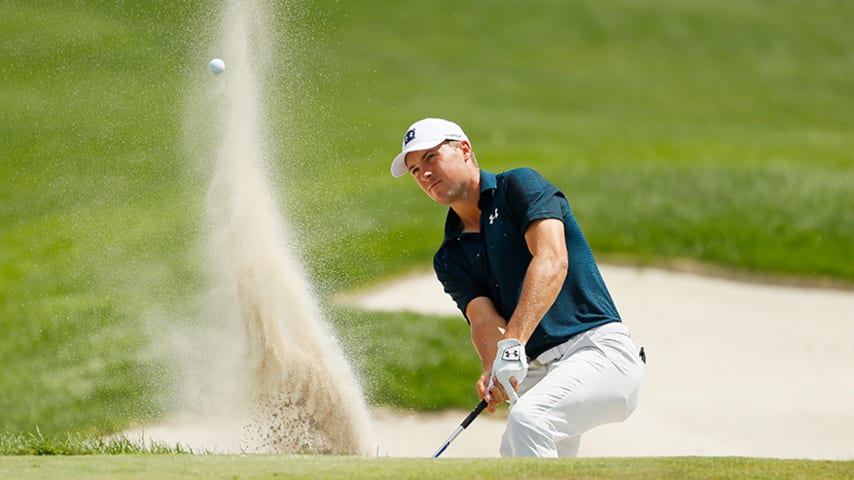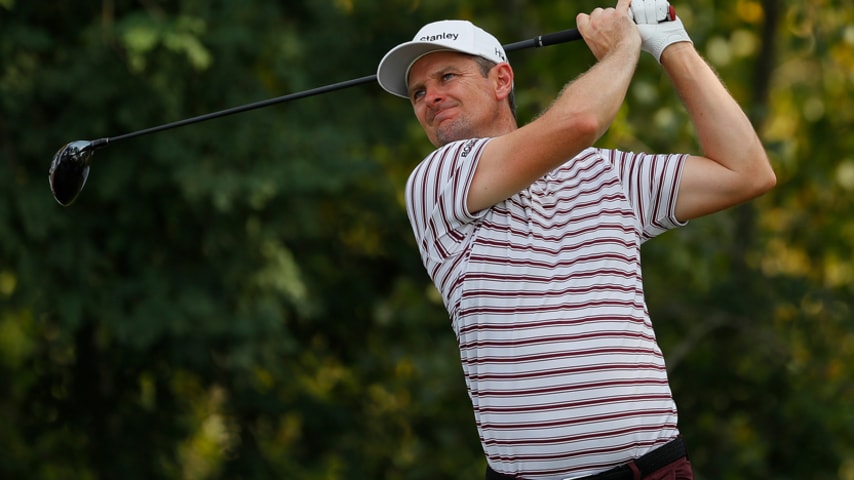Seven things you should know about Medinah
9 Min Read

The second leg of the FedExCup Playoffs brings us to the proud golfing city of Chicago. Plenty of history has been made in this area, much of it happening at Medinah Country Club. At nearly 100 years old, the club has many stories to tell and this week’s BMW Championship at Medinah No. 3 will add to those. Here’s what you need to know about this famous club.
1. It was founded by a group of Shriners from Chicago's Medinah Temple in the early 1920s.
The original founders were looking for a country retreat where they could execute their vision of building the best country club in North America. They decided to create three courses, which the club still has today.
Tom Bendelow, a world-renowned Scottish course architect, was retained to design the original three golf courses. Also on the grounds for early members -- of which there roughly 1,500 -- were tennis courts, a gun club, a baseball diamond, equestrian center, bridle paths, Lake Kadijah, a ski jump and toboggan slide as well as a log cabin warming hut.
Such was the scale of the club, the Chicago Tribune reported the railroad agreed to change the nearest station from Meacham to Medinah and also agreed to “erect a station harmonizing with the oriental architecture of the clubhouse.”
To this day, the tennis courts, gun club and Lake Kadijah remain a focal point and an Olympic-sized swimming pool has been added. The Shriners-only membership clause was removed at the end of the 1930s and the club now hosts a diverse membership.
2. Course No. 3 was originally designed for Medinah’s ladies.
Completed in 1928, the No. 3 course was overhauled not long after in the 1930s with the help of A.W. Tillinghast. Fearing a potential membership drop after the Great Depression, Medinah officials wanted to begin hosting high-profile tournaments, and the No. 3 course had the kind of topography that could toughen up the layout.
Then in 1986, Roger Packard renovated to prepare for the U.S. Senior Open (1988) and the U.S. Open (1990). In 2002, Rees Jones completed a complete course renovation in preparation for the 2006 PGA Championship.
Prior to being a major championship venue, it hosted the Chicago Open and Western Open at times. Golf legends including Harry Cooper, Byron Nelson, Gene Sarazen, Jacky Cupit and Billy Casper have played and won national tournaments at Medinah.
Course No.1 was opened in 1925 and was redesigned by Tom Doak in 2014. Course No.2 was completed in 1926 and has been redesigned recently to return to its original look. There are now seven tee boxes in play to suit all levels of golfer -- be it juniors, families and championship-level players.
3. Tiger Woods has won both PGA Championships held at Medinah No. 3.
Woods prevailed at the 1999 and 2006 PGA Championships.
In 1999, a young Spanish upstart named Sergio Garcia gave him a run for his money on Sunday. Woods had set up a comfortable cushion on Sunday as Mike Weir, the 54-hole leader, had stumbled badly and was on the way to shooting 80.
The 23-year-old Woods looked certain for his second major win with a five-shot lead on the back nine until the 19-year-old Garcia stirred things up. He made a big birdie on the par-3 13th in the group ahead of Woods and stared back at him when it went in. Woods made double bogey.
Garcia would then produce an incredible shot on the 16th after his tee shot rested against a tree. He ripped a 6-iron, with his eyes closed, around a bend and onto the green. As it climbed up towards the elevated green, Garcia sprinted after it to see the result. In the end, a clutch par putt on the 17th helped Woods hold firm to win.
“I said when I turned pro that I wanted to be the No. 1 golfer in the world,” Garcia said at the time. “And so I knew I was going to be a rival for Tiger. But I said that I want to be a rival, but always being friends like we did today.”
In 2006, things were much easier for Woods. While he was tied with Luke Donald through 54 holes he wasn’t troubled on Sunday and his final round 68 led him to a 12th major championship. He won by five shots over Shaun Micheel.
4. Sam Snead and Jack Nicklaus coughed up U.S. Opens at Medinah.
The U.S. Opens held at Medinah all have fascinating stories. Cary Middlecoff (1949), Lou Graham (1975) and Hale Irwin (1990) are U.S. Open champions from Medinah while Gary Player (1988) won the U.S. Senior Open at the venue.
In 1949, Middlecoff came through despite Sam Snead coming in as hot favorite. Snead had won his previous four events, including the Masters and the PGA Championship. With two holes to go in the final round, Snead was tied for the lead with Middlecoff in the clubhouse and looking at a third major of the year.
“But on the 193-yard lake hole 17th, Snead ran into an old and despised chum – his Open bugaboo,” the AP reported at the time.
“After laying his tee shot on the fringe of the green, he took three costly taps at the ball and there was another championship gone out the window. His first putt was six feet past and then he rimmed the cup with his next try – but the ball stayed out.”
The bogey meant he’d settle for runner-up for a third time. With another runner-up in 1953, Snead never did claim the last leg of a potential career Grand Slam.
In 1975, Jack Nicklaus, already the Masters champion, was just one shot back with three holes to play. He had begun the final round tied for 15th, a distant seven shots back, but made a big move and by the 16th tee had just two players ahead of him. In the lead-up to the tournament, Nicklaus had declared this season one of his best chances of winning a calendar Grand Slam.
But three straight bogeys to finish his final round dashed those hopes.
In the end Nicklaus, who preferred to play a fade, couldn’t get a manufactured draw to hold firm. When asked afterwards how he felt about the Grand Slam now, Nicklaus said, “Slammed. This one was the key to the Slam. This is the one I didn’t feel as confident about because of the course design. I conceived an artificial right to left swing. I wasn’t happy with it all week but it’s what you need here. I got away with it today until the 16th.”
Graham and John Mahaffey each dropped shots coming in but managed to tie at the top, with Graham winning an 18-hole playoff on Monday.
In 1990, Hale Irwin was given a special exemption as a former two-time champion to play the U.S. Open. He hadn’t won in five years. He was tied for 20th through three rounds before a final-round 67. He made five birdies in the final eight holes, capped by an incredible 60-foot putt on the 72nd hole. It was enough to force an 18-hole Monday playoff with Mike Donald.
In the playoff Irwin was two shots back with three to play. After 18, he was tied. On the first hole of sudden death, he made a 10-foot birdie to become the oldest U.S. Open champion to date at 45.
“I had said that three championships would be indescribably delicious,” Irwin said. “Well it’s every bit that. Because I’m so old I feel blessed.”
Player’s senior Open success also came in an 18-hole playoff. He beat Bob Charles.
5. Team Europe will always enjoy it after “The Miracle at Medinah” in 2012.
It was one of the greatest Ryder Cup comebacks of all-time. Down 10-4 with two matches left on the course Saturday afternoon, Europe looked dead and buried. Enter Ian Poulter. Playing with Rory McIlroy in Four-ball against Jason Dufner and Zach Johnson, Poulter found the zone. Five closing birdies sent the Englishman into a frenzy and he helped secure the match, 1-up. With Sergio Garcia and Luke Donald beating Tiger Woods and Steve Stricker by the same margin, the score heading to singles would be 10-6.
Surely still unsurmountable …
On Sunday, knowing they would need to produce the biggest comeback in Europe’s history, things started with McIlroy mistaking Central Time with Eastern Time and needing a police escort to barely make his match against Keegan Bradley. McIlroy was part of Europe’s stacked early Singles lineup. He, Donald, Poulter and Justin Rose all produced epic victories over their American counterparts to swing momentum back. Rose made some huge closing birdies against Phil Mickelson and by the time that match was over the score was 11-11.
With Garcia and Lee Westwood winning matches, it all came down to Martin Kaymer against Steve Stricker. The German nailed a 5-foot putt to secure perhaps the greatest comeback of all-time. The final score would read 14.5-13.5 after Woods conceded a half to Francesco Molinari in the meaningless anchor match.
6. Major winners Tommy Armour and Ralph Guldahl were former Medinah club pros.
Armour was born in Scotland and served in World War I before he came to America and turned professional in 1924. He won the 1927 U.S. Open, the 1930 PGA Championship and the 1931 Open Championship. His stint at Medinah was from 1933 to 1944. Armour’s many students included Babe Didrikson and Lawson Little. Armour was elected to the World Golf Hall of Fame in 1976.
From 1945-48 Guldahl was at Medinah. He won the 1937 and 1938 U.S. Opens and the 1939 Masters. He was on the 1937 Ryder Cup team. He was elected to the World Golf Hall of Fame in 1981.
7. It boasts an iconic clubhouse that was recently dubbed the best in Illinois by Architectural Digest.
In the mid-1920s, while the courses were under construction, Richard G. Schmid was hired to plan and design the clubhouse. Schmid blended classic lines of Byzantine, Oriental, Louis XIV, and Italian architecture lending to the style and elegance still evident today.
Schmidt Brothers Construction Company served as the general contractors for the clubhouse that cost $1 million (the equivalent of about $14 million today). All three brothers (Otto, August, and Ernest) were Shriners and charter members of Medinah.
The rotunda and murals were the work of club member Gustav A. Brand, a German-born artist. Brand's work was featured on the Chicago Medinah Temple and other historic sites.
On its dedication day in 1926, 15,000 people attended, according to the Chicago Tribune. In 1997, fine art conservators completed a full restoration of the clubhouse, all including all interior frescos, murals and decorative stenciling.












